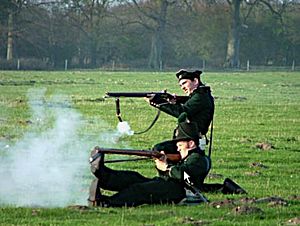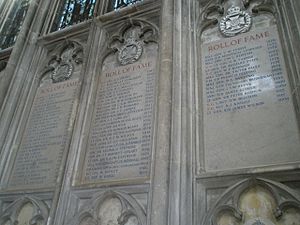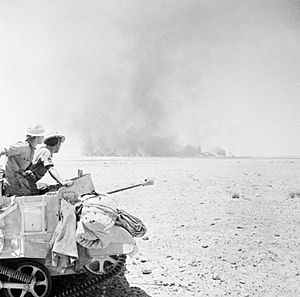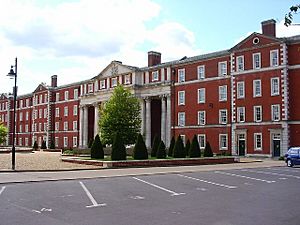Rifle Brigade (The Prince Consort's Own) facts for kids
Quick facts for kids Rifle Brigade (The Prince Consort's Own) |
|
|---|---|
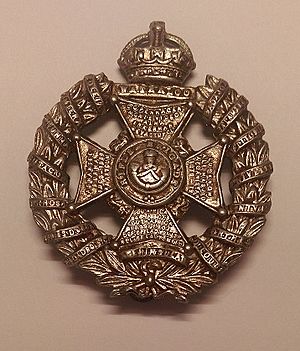
Cap badge of the Rifle Brigade
|
|
| Active | 1802–1816 as 95th Rifle Regiment, 1816–1966 as Rifle Brigade |
| Country | |
| Branch | |
| Type | Infantry |
| Role | Light infantry |
| Size | 4 Battalions in Peacetime (28 during the Great War) |
| Garrison/HQ | Peninsula Barracks, Winchester |
| Nickname(s) |
|
| March | I'm Ninety-Five |
The Rifle Brigade (The Prince Consort's Own) was a special British Army unit. It started in January 1800 as the "Experimental Corps of Riflemen." Their job was to be expert sharpshooters, scouts, and skirmishers. These soldiers were different from others in the army.
They wore green uniforms instead of the usual red coats. They also used the Baker rifle, a very accurate weapon. This was the first British-made rifle used by the British Army. In 1803, they became a regular regiment called the 95th Regiment of Foot (Rifles). After the Napoleonic Wars in 1816, they were renamed the "Rifle Brigade." They served bravely in both the First and Second World Wars. In 1966, the Rifle Brigade joined with other units to form the Royal Green Jackets.
Contents
History of the Rifle Brigade
How the Rifle Brigade Started
In 1800, a new group called the "Experimental Corps of Riflemen" was formed. Colonel Coote Manningham and Lieutenant-Colonel William Stewart led this group. Soldiers came from many different British regiments.
This new Corps was special because they used the powerful Baker rifle. This rifle was very accurate, which was unusual at the time. Riflemen wore dark green jackets instead of bright red coats. They also had black details on their uniforms and green plumes on their hats.
Early Days as the Rifle Corps
Just four months after forming, the Rifle Corps was ready for action. On August 25, 1800, three companies helped lead a British landing in Ferrol, Spain. They helped push back the Spanish defenders.
In April 1801, one company took part in the Battle of Copenhagen. They acted as expert marksmen on Royal Navy ships. During this battle, the Rifle Corps lost its first officer.
Becoming the 95th Regiment
In 1802, the Rifle Corps officially became the 95th Regiment of Foot. In 1803, they moved to Shorncliffe Army Camp, Kent. Here, they trained as light infantry under leaders like Sir John Moore.
In 1805, a second battalion was created. The 1st Battalion then went to Germany to help free Hanover from French control. They were the advance guard, meaning they led the way.
Adventures in South America
In October 1806, some companies of the 95th Regiment sailed to South America. Spain, which controlled these areas, was allied with France. The soldiers were part of a force sent to help an earlier invasion of Buenos Aires.
The 2nd Battalion helped capture Montevideo in what is now Uruguay in February 1807. They fought bravely and received much praise. They also saw action at Colonia and San Pedro.
Later, Lieutenant-General John Whitelocke led a poorly planned attack on Buenos Aires. The 95th suffered many losses in fierce fighting. They had to take shelter in a church and were eventually surrendered. After a deal was made, the soldiers were released and returned home.
Fighting in the Baltic (1807–1808)
Other companies of the 95th went to Denmark in 1807. They fought in the Battle of Copenhagen. Their goal was to capture the Danish Fleet to keep it from falling into French hands. This mission was a big success.
In 1808, the 1st Battalion went to Sweden to help in their war with Russia. However, due to misunderstandings, the troops stayed on their ships for two months. They then returned to Britain without fighting.
The Peninsular War
In August 1808, the 2nd Battalion was among the first British forces sent to Portugal. On August 15, they fired the first shots of the Peninsular War in a small fight at Óbidos. Sadly, they also had the first British officer killed in the war.
The 95th fought in the Battle of Roliça on August 17, 1808. This was the first major battle of the war. A rifleman named Thomas Plunket famously shot a French General from a very long distance in 1809.
The 1st Battalion was part of Sir John Moore's campaign, which ended with a retreat after the Battle of Corunna in January 1809. After this, the two battalions in Kent were strengthened with new volunteers. So many people wanted to join that a third battalion was formed in 1809.
The third battalion joined the army in Spain in 1810. All three battalions of the 95th fought in many important battles. They were part of the elite Light Division. Key battles included Battle of Bussaco (1810), the sieges of Ciudad Rodrigo (1812) and Badajoz (1812), and the Battle of Vitoria (1813). At the Battle of San Marcial in 1813, a company of the 95th held off an entire French division.
The Waterloo Campaign
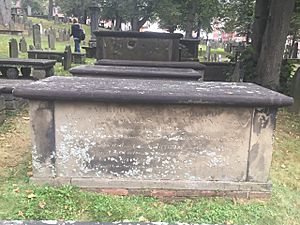
After Napoleon's first defeat in 1814, the battalions were spread out. Most returned to England for rest. However, five companies of the 3rd Battalion were in North America, fighting in the War of 1812.
When Napoleon returned from exile in 1815, all companies in England went to Belgium. They joined the forces already there. The entire regiment, except for those in America, became part of Wellington's army. The 1st Battalion fought at the Battle of Quatre Bras on June 16, 1815. All three battalions then fought together at the famous Battle of Waterloo on June 18, 1815.
The Rifle Brigade's New Name
After the Napoleonic Wars, the British Army became smaller. The 95th Regiment was too important to lose because of their special skills. So, on February 23, 1816, they were renamed the "Rifle Brigade." The famous Duke of Wellington became their leader in 1820.
Later 19th Century Battles
In 1852, Prince Albert became the regiment's leader. When the Crimean War began in 1853, two battalions of the Rifle Brigade were sent. They fought at the Battle of Alma in September 1854. They also saw action at the Battle of Inkerman and the Siege of Sevastopol. Eight soldiers from the regiment earned the Victoria Cross during this war.
The regiment also fought in the Indian Rebellion at the Siege of Lucknow in 1857. In 1862, they were given the special title "The Prince Consort's Own Rifle Brigade."
In 1866, Private Timothy O'Hea earned the Victoria Cross for bravery during peacetime. He put out a fire in a train car full of ammunition in Canada, saving many lives.
The regiment also fought in the Second Anglo-Afghan War (1878), the Third Anglo-Burmese War (1885), and the Mahdist War (1898).
In 1899, the 1st and 2nd Battalions went to South Africa for the Second Boer War. The 1st Battalion fought at the Battle of Colenso. The 2nd Battalion took part in the Siege of Ladysmith. Both battalions stayed until the war ended in 1902.
The First World War

The Rifle Brigade had many battalions fighting in the First World War. They were involved in major battles on the Western Front.
- The 1st Battalion fought in battles like the First Battle of the Marne (1914), Second Battle of Ypres (1915), and the Battle of the Somme (1916).
- The 2nd Battalion also fought on the Western Front. They were at the Battle of Neuve Chapelle (1915) and the Battle of the Somme (1916).
- The 3rd Battalion saw action at the Battle of Delville Wood (1916) and the Battle of Vimy Ridge (1917).
- The 4th Battalion served on the Western Front before moving to Salonika in 1915.
New Army Battalions
Many new battalions were formed for the war. The 7th and 8th (Service) Battalions landed in France in May 1915. They fought in the Second Battle of Ypres. Here, they saw the first use of flamethrowers by the Germans. Two soldiers from the 8th Battalion, Second Lieutenant Sidney Woodroffe and Corporal Alfred George Drake, earned the Victoria Cross.
The 9th (Service) Battalion fought in many of the same battles as the 7th and 8th. The 10th and 11th (Service) Battalions fought in battles like the Battle of Mont Sorrel (1916) and the Battle of Cambrai (1917).
The 12th (Service) Battalion also fought in many of these battles. The 13th (Service) Battalion saw action at the Battle of Loos (1915) and the Battle of the Somme (1916). The 16th (Service) Battalion fought in the Battle of the Somme (1916) and the Second Battle of Passchendaele (1917).
Between the World Wars
In 1922, the 2nd Battalion went to Turkey during the Chanak Crisis. This was a time of tension as Turkey tried to regain control of its lands.
The Second World War
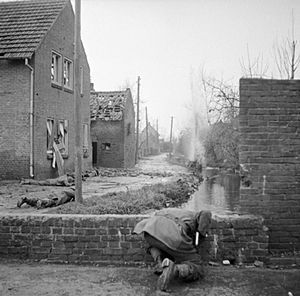
The 1st Battalion was in England when the Second World War began. In May 1940, they went to France with the British Expeditionary Force. They bravely defended Calais, slowing the German advance. This helped the Dunkirk evacuation to happen.
After reforming, the 1st Battalion fought in the North African Campaign. They destroyed many enemy tanks at the Battle of Alam el Halfa in 1942. They also fought in the Second Battle of El Alamein and the Tunisian Campaign. In 1943, they took part in the Allied invasion of Italy. In 1944, they were part of the invasion of Normandy and fought across North West Europe until the war ended in 1945.
The 2nd Battalion was in Palestine when the war started. They fought bravely in the Western Desert Campaign, especially at "Outpost Snipe" during the Second Battle of El Alamein. They knocked out over 50 German and Italian tanks. Their commander, Lieutenant Colonel Victor Buller Turner, received the Victoria Cross.
The 2nd Battalion also played a big part in the end of the Tunisian Campaign. They later fought in the Italian Campaign, including the Fourth Battle of Monte Cassino.
The 7th Battalion was formed in 1941. They fought in the First Battle of El Alamein in Egypt. They were involved in the Italian Campaign from 1944 onwards.

The 8th Battalion was formed in 1941. They took part in the invasion of Normandy in 1944 and fought in the North West Europe Campaign.
The 9th Battalion was created in 1941. They fought in the Battle of Gazala during the North African Campaign before being disbanded in 1942.
The 10th Battalion was formed in 1941. They served in Tunisia in 1942-1943. They later fought in the Italian Campaign alongside the 2nd and 7th Battalions.
After the Second World War
After 1945, some Rifle Brigade officers helped with rebuilding efforts in Germany. The 1st Battalion later served in the Mau Mau Uprising in Kenya (1954) and the Malayan Emergency (1956).
Joining Other Units
In 1958, the 1st Battalion was renamed the 3rd Green Jackets, The Rifle Brigade. On January 1, 1966, it joined with the 1st Green Jackets (43rd and 52nd) and the King's Royal Rifle Corps to create the Royal Green Jackets.
Regimental Museum
The history and items of the Rifle Brigade are kept at the Royal Green Jackets (Rifles) Museum. It is located at Peninsula Barracks in Winchester.
Battle Honours
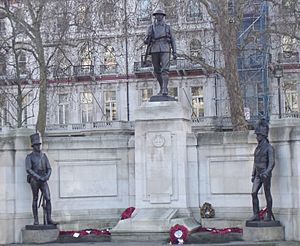
The regiment earned many special awards for its bravery in battles. These are called "battle honours":
- Copenhagen, Monte Video, Rolica, Vimiera, Corunna, Busaco, Barrosa, Fuentes d'Onor, Ciudad Rodrigo, Badajoz, Salamanca, Vittoria, Pyrenees, Nivelle, Nive, Orthes, Toulouse, Peninsula, Waterloo, South Africa 1846–47, South Africa 1851-2-3, Alma, Inkerman, Sevastopol, Lucknow, Ashantee 1873–74, Ali Masjid, Afghanistan 1878–79, Burma 1885–87, Khartoum, Defence of Ladysmith, Relief of Ladysmith, South Africa 1899–1902
- The Great War (21 battalions): Le Cateau, Retreat from Mons, Marne 1914, Aisne 1914 '18, Armentières 1914, Neuve Chapelle, Ypres 1915 '17, Gravenstafel, St. Julien, Frezenberg, Bellewaarde, Aubers, Hooge 1915, Somme 1916 '18, Albert 1916 '18, Bazentin, Delville Wood, Guillemont, Flers-Courcelette, Morval, Le Transloy, Ancre Heights, Ancre 1916 '18, Arras 1917 '18, Vimy 1917, Scarpe 1917 '18, Arleux, Messines 1917, Pilckem, Langemarck 1917, Menin Road, Polygon Wood, Broodseinde, Poelcappelle, Passchendaele, Cambrai 1917 '18, St. Quentin, Rosières, Avre, Villers Bretonneux, Lys, Hazebrouck, Béthune, Drocourt-Quéant, Hindenburg Line, Havrincourt, Canal du Nord, Selle, Valenciennes, Sambre, France and Flanders 1914–18, Macedonia 1915–18
- The Second World War: Calais 1940, Villers Bocage, Odon, Bourguébus Ridge, Mont Pincon, Le Perier Ridge, Falaise, Antwerp, Hechtel, Nederrijn, Lower Maas, Roer, Leese, Aller, North-West Europe 1940 '44–45, Egyptian Frontier 1940, Beda Fomm, Mersa el Brega, Agedabia, Derna Aerodrome, Tobruk 1941, Sidi Rezegh 1941, Chor es Sufan, Saunnu, Gazala, Knightsbridge, Defence of Alamein Line, Ruweisat, Alam el Halfa, El Alamein, Tebaga Gap, Medjez el Bab, Kassarine, Thala, Fondouk, Fondouk Pass, El Kourzia, Djebel Kournine, Tunis, Hammam Lif, North Africa 1940–43, Cardito, Cassino II, Liri Valley, Melfa Crossing, Monte Rotondo, Capture of Perugia, Monte Malbe, Arezzo, Advance to Florence, Gothic Line, Orsara, Tossigniano, Argenta Gap, Fossa Sembalina, Italy 1943–45
Famous Members of the Rifle Brigade
Many notable people served in the Rifle Brigade:
- John Baird – A rifleman who was also a revolutionary.
- Thomas Sydney Beckwith – An officer who served in the Peninsular War.
- James Fullarton – An officer who fought at the Battle of Waterloo.
- William Green – A rifleman and writer.
- Benjamin Randell Harris – Another rifleman and writer.
- Major-General Sir Henry Havelock – An officer who became famous in India.
- Sir John Kincaid – An officer who wrote about his experiences under Wellington.
- Alfred Mendes – An author and grandfather of director Sam Mendes.
- David Niven – A lieutenant who later became a famous actor.
- Thomas Plunket – A rifleman known for shooting a French general from afar.
- Sir Harry Smith, 1st Baronet – An officer who fought at Badajoz and Waterloo.
See also
- History of British light infantry
- New Zealand Rifle Brigade (Earl of Liverpool's Own) – A World War I unit.
- 60th King's Royal Rifle Corps – A similar regiment with shared history.
- Richard Sharpe – A fictional hero from books about the 95th.
- Rifleman Dodd – Another fictional hero from a book about the 95th.


